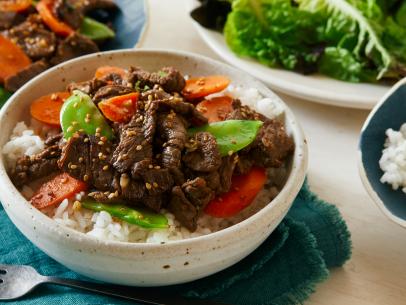
Hunan Beef and Peppers (Pop) and Sesame Shao Bing (Chinese Pita)
- Total: 3 hr
- Prep: 2 hr 30 min
- Cook: 30 min
- Yield: 4 servings
- Total: 3 hr
- Prep: 2 hr 30 min
- Cook: 30 min
- Yield: 4 servings
Ingredients
Shao Bing:
Directions
- In a bowl, mix together steak, garlic, ginger, soy sauce, black pepper, wine, chiles, and cornstarch. Let marinate at least 2 hours, but preferably refrigerated overnight.
- Strain the beef and reserve marinade. In a very hot wok filled 1/4 with peanut oil, 'blanch' the beef for 5 seconds only. Set beef aside and pour off all but 2 tablespoons of oil.
- Stir-fry the onions and bell peppers for 3 minutes then add back the beef and the reserved marinade. Bring to a boil and reduce by 50 percent, until thickened.
- Stuff Hunan Beef in the Shao Bing and consume immediately.
- Suggested beverage: Loose teas and Hartley Ostini "Hitching Post" Pinot Noir 1997
Shao Bing:
- Prepare a saucepan filled with the vegetable oil over medium heat. Slowly add 2 cups of the wheat flour, stirring slowly to ensure that the paste achieves a smooth consistency. Cook for about 5 minutes and then set aside to cool. This is the oil paste.
- In a mixing bowl, dissolve the yeast and sugar in a little warm water. Add 2 cups of the wheat flour and the baking powder and combine. Add more warm water to achieve a dough consistency. Cover the dough with plastic and allow the dough to rise, 45 minutes.
- In a large mixing bowl, combine 1 cup of boiling water with 2 pounds of the wheat flour. Mix until it has a slightly lumpy consistency and then add 1 or more cups of cold water. Continue mixing and kneading until the dough is soft and smooth. Cover the dough with plastic or cloth and let rest for 30 minutes.
- Add the warm water dough to the shao bing and knead until the doughs are incorporated. Cover the mixture and let sit for 15 minutes.
- On a well-floured surface, roll the dough into a flat, rectangular sheet, about 1/16 to 1/8-inch in thickness.
- Spread a generous layer of the oil paste over the surface of the dough. To prevent the oil paste from running off the dough, sprinkle lightly with flour.
- Starting from 1 edge, roll the dough until it becomes 1-inch in diameter. Be sure that the roll is tight. Cut the dough sheet so that the rolled dough may be removed when the diameter is 1 inch. Repeat the process until the entire sheet is transformed into rolls.
- Carefully, so as not to let the oil paste leak out, stretch out the rolls so that the diameter is reduced to 3/4 of an inch. Cut the stretched roll into 4-inch lengths.
- Place 1 of the rolls seam-side up and seal the end using a small rolling pin (this will prevent the oil paste from escaping). Fold the roll into thirds, so that the seam is covered. Then roll this tripled roll into a flat dough about 5-inches by 2-inches. Fold this piece into thirds. The stack should be about 2 by 3/4 inches thick. Flip the piece over so that the seam and fold are on the bottom. Cover and set aside. Repeat the process for the remaining rolls.
- Spread the sesame seeds onto a clean work surface. Flip the square with the smooth face over, onto the sesame seeds. Next, the square may be rolled into either a round or rectangular shape. The round is used in Northern China while the rectangular is common in the South. Rolling presses the sesame seeds into the face of the Shao Bing.
- Preheat the oven to 350 degrees. Place the Shao Bing, sesame seed side down, onto a cookie sheet. Bake for 10 minutes and then flip and bake for another 5 minutes to brown the bottom.
- The uncooked Shao Bing may be frozen for future use. Place the Shao Bing between layers of waxed paper to prevent them from sticking to each other.
- Using scissors as one does in China, cut open the Shao Bing, like you would a pita bread pocket.
Cook’s Note
Salt may be added at any time before the dough is rolled. In Northern China, it is common to dust ground Szechuan peppercorns and salt over the sheet before the oil paste is spread. In addition, seeds other than sesame may be used. The key is to add them to the smooth surface so that the seeds will stick.
Looking for Something Else?
Related Pages
- Chicken and Chinese Sausage Rice Hot Pot Recipe
- Spicy Chinese Long Beans Recipe
- Honey Sesame Tuiles Recipe
- Whole Crispy Brook Trout with Mango-Pineapple...
- Bean Sprout Salad with Warm Shiitakes, Chinese...
- Leftovers
- Ming's Bings Recipe
- Zha Jiang Mian Meatless Chinese Spaghetti Recipe
- Ahi Tuna Tartar with Sesame Asparagus Vinaigrette...































